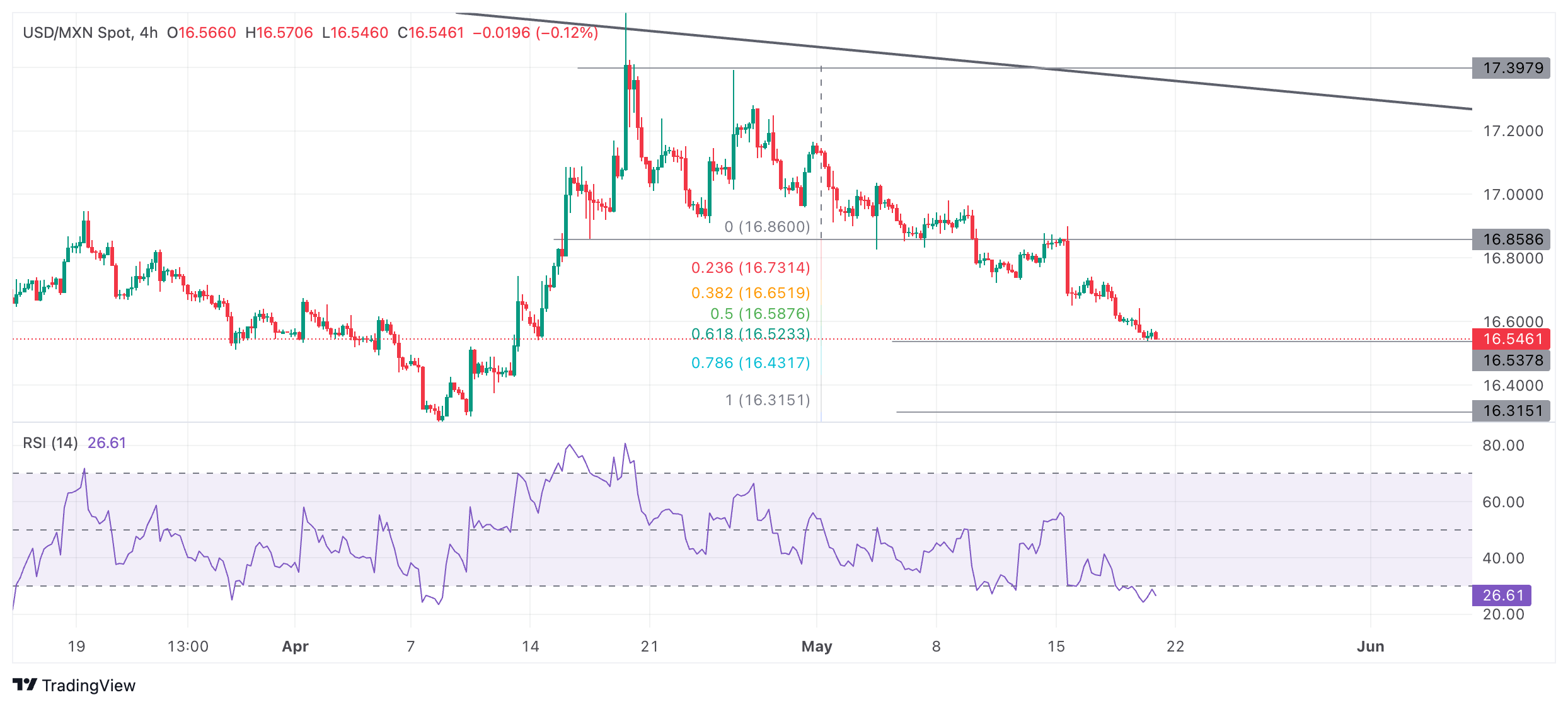Most recent article: Mexican Peso tumbles amid concerns of economic slowdown
- The Mexican Peso trades mixed in its key pairs after poor Mexican data and risk aversion.
- The wide interest-rate differential between Mexico and Western countries continues to favor the Peso in the carry trade.
- USD/MXN hits the conservative target for its range breakout.
The Mexican Peso (MXN) seesaws between marginal gains and losses in its key pairs on Tuesday after shrugging off poor Retail Sales data from Mexico and hawkish commentary from Federal Reserve (Fed) speakers on Monday, and continuing to drift higher.
The wide interest-rate differential between Mexico and most major economies – with relatively higher interest rates in Mexico (11.00%) providing an attractive draw for carry traders – is a key factor driving MXN’s uptrend, with little prospect of the gap closing anytime soon.
USD/MXN is trading at 16.55, EUR/MXN at 17.98 and GBP/MXN at 21.05, at the time of writing.
Mexican Peso shrugs off poor data
The Mexican Peso trades relatively flat on Tuesday despite recent data showing a fall in Mexican Retail Sales on both a monthly and yearly basis.
Whilst the data indicated the high interest rates imposed by the Bank of Mexico (Banxico) are probably having the desired effect of cooling the economy, Banxico has not signaled it is in a hurry to reduce interest rates yet.
Indeed on Friday, the Deputy Governor of Banxico, Irene Espinosa, said she thought interest rates should remain at their current level until inflation had been brought down on a sustainable basis.
Somber market mood caps Peso’s upside
The generally somber market mood on Tuesday is capping the Peso’s upside, however, as investors retreat from risk assets and commodities – MXN included – out of a fear high interest rates are here to stay. Asian stocks are down and Oil, metals and softs are following suit.
The change in sentiment comes as a result of commentary from central bankers, in both the US and Australia, that suggests they are not only reluctant to cut interest rates in the near future but are even discussing raising them.
In the US, Federal Reserve Bank of Cleveland President Loretta Mester said inflation risks were “tilted to the upside”, that the Fed could “even raise them (rates)” if inflation rose, and that it was “no longer appropriate” to expect the Fed to make three cuts this year.
The minutes of the RBA May meeting, released on Tuesday morning, showed that the board of governors discussed the possibility of raising interest rates. It was the first time in many months they had discussed further policy tightening.
Technical Analysis: USD/MXN hits first downside target
USD/MXN – or the number of Pesos that can be bought with one US Dollar – edges lower on Tuesday, continuing its overall bearish bias of recent weeks.
USD/MXN 4-hour Chart
USD/MXN is falling in a short-term downtrend within a descending channel that favors short bets over longs.
The pair has now just reached its conservative price objective for the breakout of the mid-April to May range at 16.54. This is calculated as the 0.618 Fibonacci ratio of the range's height extrapolated lower.
Further bearishness could still see USD/MXN reach 16.34, the more bearish target, calculated by taking the full height of the range and extrapolating it lower.
The Relative Strength Index (RSI) momentum indicator is still oversold, which indicates traders should not add to their short positions. If the RSI exits oversold conditions and returns to neutral territory above 30, it would be a signal to close existing short positions as a correction is probably underway. Once the correction ends, however, the descending channel is expected to continue taking prices lower in line with the dominant downtrend.
Given the medium and long-term trends are also bearish, the odds further favor more downside.
Banxico FAQs
The Bank of Mexico, also known as Banxico, is the country’s central bank. Its mission is to preserve the value of Mexico’s currency, the Mexican Peso (MXN), and to set the monetary policy. To this end, its main objective is to maintain low and stable inflation within target levels – at or close to its target of 3%, the midpoint in a tolerance band of between 2% and 4%.
The main tool of the Banxico to guide monetary policy is by setting interest rates. When inflation is above target, the bank will attempt to tame it by raising rates, making it more expensive for households and businesses to borrow money and thus cooling the economy. Higher interest rates are generally positive for the Mexican Peso (MXN) as they lead to higher yields, making the country a more attractive place for investors. On the contrary, lower interest rates tend to weaken MXN. The rate differential with the USD, or how the Banxico is expected to set interest rates compared with the US Federal Reserve (Fed), is a key factor.
Banxico meets eight times a year, and its monetary policy is greatly influenced by decisions of the US Federal Reserve (Fed). Therefore, the central bank’s decision-making committee usually gathers a week after the Fed. In doing so, Banxico reacts and sometimes anticipates monetary policy measures set by the Federal Reserve. For example, after the Covid-19 pandemic, before the Fed raised rates, Banxico did it first in an attempt to diminish the chances of a substantial depreciation of the Mexican Peso (MXN) and to prevent capital outflows that could destabilize the country.
Information on these pages contains forward-looking statements that involve risks and uncertainties. Markets and instruments profiled on this page are for informational purposes only and should not in any way come across as a recommendation to buy or sell in these assets. You should do your own thorough research before making any investment decisions. FXStreet does not in any way guarantee that this information is free from mistakes, errors, or material misstatements. It also does not guarantee that this information is of a timely nature. Investing in Open Markets involves a great deal of risk, including the loss of all or a portion of your investment, as well as emotional distress. All risks, losses and costs associated with investing, including total loss of principal, are your responsibility. The views and opinions expressed in this article are those of the authors and do not necessarily reflect the official policy or position of FXStreet nor its advertisers. The author will not be held responsible for information that is found at the end of links posted on this page.
If not otherwise explicitly mentioned in the body of the article, at the time of writing, the author has no position in any stock mentioned in this article and no business relationship with any company mentioned. The author has not received compensation for writing this article, other than from FXStreet.
FXStreet and the author do not provide personalized recommendations. The author makes no representations as to the accuracy, completeness, or suitability of this information. FXStreet and the author will not be liable for any errors, omissions or any losses, injuries or damages arising from this information and its display or use. Errors and omissions excepted.
The author and FXStreet are not registered investment advisors and nothing in this article is intended to be investment advice.
Recommended content
Editors’ Picks

AUD/USD appreciates as US Dollar remains subdued after a softer inflation report
The Australian Dollar steadies following two days of gains on Monday as the US Dollar remains subdued following the Personal Consumption Expenditures Price Index data from the United States released on Friday.

USD/JPY consolidates around 156.50 area; bullish bias remains
USD/JPY holds steady around the mid-156.00s at the start of a new week and for now, seems to have stalled a modest pullback from the 158.00 neighborhood, or over a five-month top touched on Friday. Doubts over when the BoJ could hike rates again and a positive risk tone undermine the safe-haven JPY.

Gold downside bias remains intact while below $2,645
Gold price is looking to extend its recovery from monthly lows into a third day on Monday as buyers hold their grip above the $2,600 mark. However, the further upside appears elusive amid a broad US Dollar bounce and a pause in the decline of US Treasury bond yields.

Week ahead: No festive cheer for the markets after hawkish Fed
US and Japanese data in focus as markets wind down for Christmas. Gold and stocks bruised by Fed, but can the US dollar extend its gains? Risk of volatility amid thin trading and Treasury auctions.

Bank of England stays on hold, but a dovish front is building
Bank of England rates were maintained at 4.75% today, in line with expectations. However, the 6-3 vote split sent a moderately dovish signal to markets, prompting some dovish repricing and a weaker pound. We remain more dovish than market pricing for 2025.

Best Forex Brokers with Low Spreads
VERIFIED Low spreads are crucial for reducing trading costs. Explore top Forex brokers offering competitive spreads and high leverage. Compare options for EUR/USD, GBP/USD, USD/JPY, and Gold.
